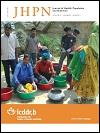Community Health Workers Can Identify and Manage Possible Infections in Neonates and Young Infants: MINI - A Model from Nepal
DOI:
https://doi.org/10.3329/jhpn.v29i3.7873Keywords:
Antibiotic use, Bacterial infections, Drug therapy, Health workers, Infant, Newborn, Neonatal mortality, Sepsis, NepalAbstract
The mortality rates of infants and children aged less than five years are declining globally and in Nepal but less among neonates. Most deliveries occur at home without skilled attendants, and most neonates may not receive appropriate care through the existing medical systems. So, a community-based pilot programme - Morang Innovative Neonatal Intervention (MINI) programme - was implemented in Morang district of Nepal to see the feasibility of bringing the management of sick neonates closer to home. The objective of this model was to answer the question: “Can a team of female community health volunteers and paid facility-based community health workers (collectively called CHWs) within the existing heath system correctly follow a set of guidelines to identify possible severe bacterial infection in neonates and young infants and successfully deliver their treatment?” In the MINI model, the CHWs followed an algorithm to classify sick young infants with possible severe bacterial infection (PSBI). Female Community Health Volunteers (FCHVS) were trained to visit homes soon after delivery, record the birth, counsel mothers on essential newborn care, and assess the newborns for danger-signs. Infants classified as having PSBI, during this or subsequent contacts, were treated with co-trimoxazole and referred to facility-based CHWs for seven-day treatment with injection gentamicin. Additional supervisory support was provided for quality of care and intensified monitoring. Of 11,457 livebirths recorded during May 2005 - April 2007, 1,526 (13.3%) episodes of PSBI were identified in young infants. Assessment of signs by the FCHVs matched that of more highly-trained facility-based CHWs in over 90% of episodes. Treatment was initiated in 90% of the PSBI episodes; 93% completed a full course of gentamicin. Case fatality in those who received treatment with gentamicin was 1.5% [95% confidence interval (CI) 1.0-2.3] compared to 5.3% (95% CI 2.6-9.7) in episodes that did not receive any treatment. Within the existing government health infrastructure, the CHWs can assess and identify possible infections in neonates and young infants and deliver appropriate treatment with antibiotics. This will result in improvement in the likelihood of survival and address one of the main causes of neonatal mortality.
Key words: Antibiotic use; Bacterial infections; Drug therapy; Health workers; Infant, Newborn; Neonatal mortality; Sepsis; Nepal
DOI: http://dx.doi.org/10.3329/jhpn.v29i3.7873
J HEALTH POPUL NUTR 2011 Jun;29(3):255-264
Downloads
430
287

